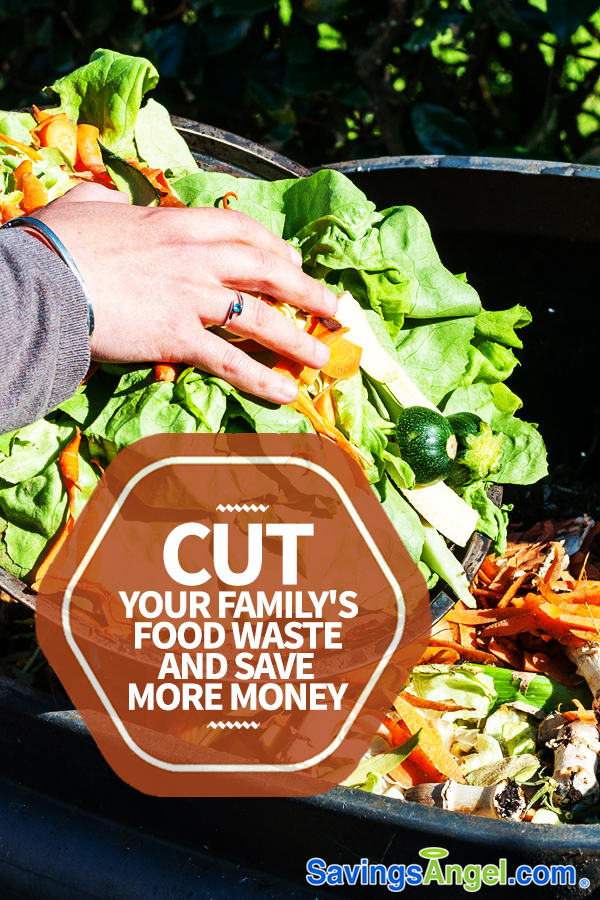
Cut your family’s food waste and save more money
At SavingsAngel.com, it’s always been part of our mission to help end hunger in America. Cutting food waste, and saving money on groceries so a family’s budget can stretch, are both big parts of that. When you cut your family’s food waste, you don’t have to spend so much restocking groceries. And for many Americans, that can be the difference on whether or not there is enough to eat later in a month when money gets tight.
This issue seems to really come to the forefront at the end of every school year, though I strongly believe it should be discussed and awareness should be heightened all year round. Why the end of the school year? The sad fact is, there are many school children who get their most complete and filling meals at school. When they are in school, their families need less food in the house. This results in a lower food budget and makes getting by a bit easier. When the kids are home all day on summer break, having enough to eat around the house gets tougher.
If you’re a family that faces a lack of enough food, please know my heart goes out to you and I want to help with my knowledge. And even if you’re not a family that faces this personally, please use the ideas I share to help reduce your own food waste. By your family throwing away less, you can stretch your own supply, making giving to food banks and friends or family who need help, that much easier.
Here are 5 ideas to cut your family’s food waste and save more money:
#1 – Stock up!
As a consumer advocate, I’ve always encouraged families to stock up when deals are 50% off or better. For a good portion of food items, this is easy enough to do. Products are packaged to have a long shelf life. Mainly, you just need a good plan for using them up in a reasonable amount of time. I recommend having a good meal plan and, at least once a month, going through the pantry and freezer to use up the oldest items. This alone will eliminate a lot of food waste and save you money over having to re-buy things.
#2 – Refrigerate or even freeze more foods.
Using fresh products up like meats, produce, bread, and dairy in a timely manner can be tricky. The hotter it gets outside, the more quickly things spoil. Be sure to keep almost everything, including bread products, in the fridge to slow down spoiling. Consider breaking up packages of food items you won’t eat quickly into smaller packages and freezing. This works especially well for meats, cheeses, and bread products. Proper storage and thawing are the keys to ingredients still being in a similar condition to fresh. (I say similar because you won’t get any argument from me that freezing does change the taste and texture of foods. But I’ll take a slightly altered texture over wasting food any day.)
#3 – Don’t believe everything you read – at least not on food labels.
As I reported last year, proposals have been made to adjust the way food labels are worded, to make it more clear whether or not food is actually still edible or not. Currently, the wording used for food label dating is confusing, leading Americans to throw away thousands of pounds of perfectly good food every year. For example, terminology like “Best By” dates don’t necessarily indicate the food isn’t safe to eat. It is often only the furthest date out from manufacturing that the manufacturer will guarantee the food’s freshness and helps indicates when stores should pull unsold food from their shelves. Instead of only reading the date on the label and assuming food should be thrown out, use sites like StillTasty.com and USDA.gov and your senses of sight and smell to evaluate whether to eat or to toss.
#4 – Buy those close-dated packages.
Grocery stores pull an astronomical amount of still-good food from the shelves every day. You can help reduce that waste – and save money – by buying some of those marked-down products. Often products can go right into the freezer when you get home.
One bargain you can find is meat since most are packaged with a date of “Use OR freeze by”. If you don’t see marked down packages very often, don’t be shy to ask where they put close-dated items or what days of the week they comb the shelves looking for items. All stores have a procedure in place for this.
In the near future, I’m hoping grocers will get onboard with pricing technology offered by a company called Wasteless. This technology facilitates identifying and marking down products lower and lower, the closer the sell-by (or best-by) dates get. Consumers save more by purchasing closer-dated products, and grocers move more product rather than “wasting out” so much.
#5 – Prepare smaller portions and/or have a plan for all leftovers.
Leftovers end up as food waste too easily when you prepare portions that are too large. And when you don’t have a solid plan for what to make with the leftovers. One way to use up leftovers is to experiment with simple casseroles. Or you can more properly portion what you cook to eliminate leftovers. I find catering amounts (you can find standard guides online) to be helpful in determining proper portion sizes for family meals.
Minimizing waste of summer produce
Stop throwing out perfectly good food!


